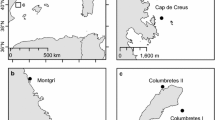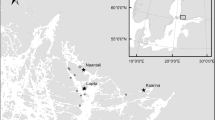Abstract
Populations of marine bivalves are known to be unstable but it is unclear whether this instability has internal or external causes. In this paper we summarize results from long-term (1978–2007) monitoring of an Astarte borealis (Astartidae) population in the White Sea. We sought significant long-term changes among a population of subtidal clams existing under relatively stable conditions. The studied population was initially (in 1978–1995) formed exclusively by adult clams, with no recruitment occurring until a mass inflow of unidentified astartid’s juveniles in the late 1990s. We assessed the suitability of periostracum microsculpture for identification of astartid juveniles and identified the juveniles recruited the population as A. borealis. Thus significant changes in population structure were detected. Our study suggests that A. borealis may have a very long life span (>20 years) and a prolonged recruitment failure could be associated with scarcity of hard substrates needed for egg attachment in a silted environment. As old clams died, their valves provided a hard substrate on the bottom surface, facilitating recruitment. We propose a new conceptual model of subtidal clams’ population dynamics predicting long-term cyclic changes driven by internal mechanisms associated with an unusual type of positive influence of adults upon recruits.









Similar content being viewed by others
References
Aleksandrov, D. A. & E. A. Ninburg, 1983. Investigation of shallow bay benthos of the White Sea. Communities of Ilistaya Inlet subtidal. Vestnik Leningradskogo Gosudarstvennogo Universiteta 9: 18–26. (in Russian).
Aleksandrov, D. A., 1984. In Filippova, L. N., V. V. Bianki, V. N. Karpovich & E. Ya. Pacia (eds), About benthos structure of the White Sea shallows in relation with the problems of its mapping. Problems of Nature Preservation in the White Sea Basin, Murmansk: 98–106. (in Russian).
André, C. & R. Rosenberg, 1991. Adult-larval interactions in the suspension-feeding bivalves Cerastoderma edule and Mya arenaria. Marine Ecology Progress Series 71: 227–234.
André, C., P. R. Jonsson & M. Lindegarth, 1993. Predation on settling bivalve larvae by benthic suspension feeders: the role of hydrodynamics and larval behavior. Marine Ecology Progress Series 97: 183–192.
Beaumont, A. R., M. P. Hawkins, F. L. Doig, I. M. Davies & M. Snow, 2008. Three species of Mytilus and their hybrids identified in a Scottish Loch: natives, relicts and invaders? Journal of Experimental Marine Biology and Ecology 367: 100–110.
Beukema, J. J., R. Dekker, K. Essink & H. Michaelis, 2001. Synchronized reproductive success of the main bivalve species in the Wadden Sea: causes and consequences. Marine Ecology Progress Series 211: 143–155.
Beukema, J. J., R. Dekker & C. J. M. Philippart, 2010. Long-term variability in bivalve recruitment, mortality, and growth and their contribution to fluctuations in food stocks of shellfish-eating birds. Marine Ecology Progress Series 414: 117–130.
Casagrandi, R., L. Mari & M. Gatto, 2007. Modeling the local dynamics of the zebra mussel (Dreissena polymorpha). Freshwater Biology 52: 1223–1238.
Coan, E. V., P. V. Scott, & F. R. Bernard, 2000. Bivalve seashells of western north America. Marine Bivalve Mollusks from Arctic Alaska to Baja California. Santa Barbara Museum of Natural History Monographs. Studies in Biodiversity, Santa-Barbara.
Diederich, S., G. Nehls, J. E. E. van Beusekom & K. Reise, 2005. Introduced Pacific oysters (Crassostrea gigas) in the northern Wadden Sea: invasion accelerated by warm summers? Helgoland Marine Research 59: 97–106.
Denisenko, S. G., 2000. Surface microsculpture of Astartidae family shells from the northern Russian seas. In Alimov, A. F., B. I. Sirenko & E. N. Egorova (eds), Marine mollusks: problems of taxonomy, ecology and phylogeny. 5 (14) Proceedings of the conference on studies of mollusks in memoriam to Acad. O. A. Scarlato, Zoological Institute, Saint Petersburg: 34–35 (in Russian).
Gutierrez, J. L., C. G. Jones, D. L. Stayer & O. O. Iribarne, 2003. Mollusks as ecosystem engineers: the role of shell production in aquatic habitats. Oikos 101: 79–90.
Hayward, B. W. & J. D. Stilwell, 1995. Floating cockle shells (Austrovenus stutchburyi) – their significance to paleoenvironmental assessment. Tane 35: 143–148.
Herlyn, M., G. Millar & B. Petersen, 2008. Documentation of sites of intertidal blue mussel (Mytilus edulis L.) beds of the Lower Saxonian Wadden Sea, southern North Sea (as of 2003) and the role of their structure for spatfall settlement. Helgoland Marine Research 62: 177–188.
Hertweck, G. & G. Liebezeit, 2002. Historic mussel beds (Mytilus edulis) in the sedimentary record of a back-barrier tidal flat near Spiekeroog Island, southern North Sea. Helgoland Marine Research 56: 51–58.
Hickman, R. W., 1992. Mussel cultivation. In Gosling, E. (ed.), The Mussel Mytilus: ecology, physiology, genetics and culture. Elsevier, Amsterdam.
Khaitov, V. M., 1999. Communities of benthic invertebrates associated with natural mussel assemblages: structure, dynamics and biotic interactions. PhD thesis. Saint-Petersburg State University (in Russian).
Khaitov, V. M., & N. Yu. Kochetkova, 2001. Nutrition of Priapulus caudatus Lamarck, 1816 in subtidal zone of the White Sea soft bay. Vestnik Sankt-Petersburgskogo Universiteta Series 3 (Biology): 90–92 (in Russian with English summary).
Kühlmorgen-Hille, G., 1963. Quantitative Untersuchungen der Bodenfauna in der keler Bucht und ihre jahreszeitlichen Veranderungen. Kieler Meeresforschungen 19: 42–66.
Lappalainen, A., M. Westerbom & S. Vesala, 2004. Blue mussels (Mytilus edulis) in the diet of roach (Rutilus rutilus) in outer archipelago areas of the western Gulf of Finland, Baltic Sea. Hydrobiologia 514: 87–92.
Matveeva, T. A., 1977. Features of reproduction of bivalves from family Astartidae. In Golikov, A. N. (ed.), Exploration of the Fauna of the Seas, Vol. 14. Zoological Institute of Russian Academy of Science, Leningrad, Nauka: 418–427 (in Russian with English summary).
Maximovich, N. V., 1980. Peculiarities of ecology of several abundant bivalves from the White Sea. PhD thesis. Leningrad State University.
Möller, P., 1986. Physical factors and biological interactions regulating infauna in shallow boreal areas. Marine Ecology Progress Series 30: 33–47.
Naumov, A. D., 2006. Clams of the White Sea: ecological and faunistic analysis. Zoological Institute RAS, Saint-Petersburg (in Russian).
Nehls, G., I. Hertzler & G. Scheiffarth, 1997. Stable mussel Mytilus edulis beds in the Wadden Sea – they’re just for the birds. Helgoländer Meeresuntersuchungen 51: 361–372.
Ninburg, E. A., 1984. Several principles of benthic biocenosis forming in shallow bays of Kandalaksha. In Filippova L. N., V. V. Bianki, V. N. Karpovich & E. Ya. Pacia (eds), Problems of Nature Preservation in the White Sea Basin, Murmansk: 114–121 (in Russian).
Reise, K., E. Herre & M. Sturm, 2008. Mudflat biota since the 1930s: change beyond return? Helgoland Marine Research 62: 13–22.
Saleuddin, A. S. M., 1974. An electron microscopic study of the formation and structure of the periostracum in Astarte (Bivalvia). Canadian Journal of Zoology 52: 1463–1471.
Scheiffarth, G. & G. Nehls, 1997. Consumption of benthic fauna by carnivorous birds in the Wadden Sea. Helgoländer Meeresuntersuchungen 51: 373–387.
Selin, N. I., 2007. Shell form, growth and life span of Astarte arctica and A. borealis (Mollusca: Bivalvia) from the subtidal zone of Northeastern Sakhalin. Russian Journal of Marine Biology 33: 232–237.
Smith, J. R., P. Fong & R. F. Ambrose, 2006. Dramatic declines in mussel bed community diversity: response to climate change? Ecology 87: 1153–1161.
Somerfield, P. J., K. R. Clarke & F. Olsgard, 2002. A comparison of the power of categorical and correlational tests applied to community ecology data from gradient studies. Journal of Animal Ecology 71: 581–593.
Steenbergen, J., J. M. D. D. Baars, M. R. van Stralen & J. A. Craeymeersch, 2006. Winter survival of mussel beds in the intertidal part of the Dutch Wadden Sea. In Laursen, K. (ed.), Monitoring and Assessment in the Wadden Sea. Proceedings from the 11th Scientific Wadden Sea Symposium, Denmark, Esbjerg 4–8 April, 2005. NERI Technical Report No. 573, pp. 107–111.
Stott, F. C., 1936. The marine foods of birds in an Inland Fjord Region in West Spitsbergen: part 1. Plankton and in Shore Benthos. Journal of Animal Ecology 5: 356–369.
Strayer, D. L. & H. M. Malcom, 2006. Long-term demography of a zebra mussel (Dreissena polymorpha) population. Freshwater Biology 51: 117–130.
Thorson, G., 1936. The larval development, growth and metabolism of Arctic marine bottom invertebrates compared with those of other seas. Meddelelser om Grønland, Denmark.
Trutschler, K. & C. Samtleben, 1988. Shell growth of Astarte elliptica (Bivalvia) from Kiel Bay (Western Baltic Sea). Marine Ecology Progress Series 42: 155–162.
Underwood, A. J. & M. J. Keough, 2001. Supply-side ecology: the nature and consequences of variations in recruitment of intertidal organisms. In Bertness, M. D., S. D. Gaines & M. E. Hay (eds), Marine Community Ecology. Sinauer Associates Inc., Sunderland, Maine: 183–200.
von Oertzen, J. A., 1972. Cycles and rates of reproduction of six Baltic Sea bivalves of different zoogeographical origin. Marine Biology 14: 143–149.
Voultsiadou, E., D. Koutsoubas & M. Achparaki, 2009. Bivalve mollusc exploitation in Mediterranean coastal communities: an historical approach. Journal of Biological Research-Thessaloniki 12: 1–11.
Woodin, S. A., 1976. Adult-larval interactions in dense faunal assemblages: patterns and abundance. Journal of Marine Research 34: 25–41.
Zettler, M. L., 2002. Ecological and morphological features of the bivalve Astarte borealis (Schumacher, 1817) in the Baltic Sea near its geographical range. The Journal of Shellfish Research 21: 33–40.
Zolotarev, V. N., 1989. Scleroconchology of bivalve mollusks. Naukova Dumka, Kiev (in Russian).
Acknowledgements
We acknowledge the students of the Laboratory of Marine Benthic Ecology and the staff of Kandalaksha Nature Reserve for their help during fieldwork. We would like to express our special thanks to Alexander Gornykh for help in the field and discussion of the results. We are grateful to Natalia Lentsman and Anna Gonchar for comprehensive linguistic assistance and improvement of the text. We thank Dr Alexey Sukhotin and anonymous referees whose comments much improved the final product. With this paper we would like to pay a tribute to our teacher, the late Eugeny Ninburg, who initiated these investigations and suggested the main ideas of this work.
Author information
Authors and Affiliations
Corresponding author
Additional information
Guest editor: A. A. Sukhotin / Long-term research on marine ecosystems in the White Sea, Russia
Rights and permissions
About this article
Cite this article
Skazina, M., Sofronova, E. & Khaitov, V. Paving the way for the new generations: Astarte borealis population dynamics in the White Sea. Hydrobiologia 706, 35–49 (2013). https://doi.org/10.1007/s10750-012-1271-1
Received:
Accepted:
Published:
Issue Date:
DOI: https://doi.org/10.1007/s10750-012-1271-1




